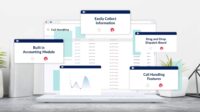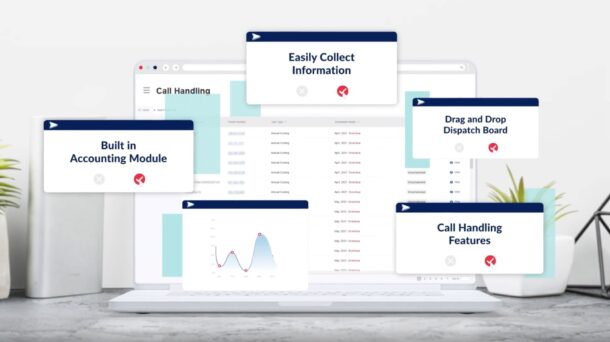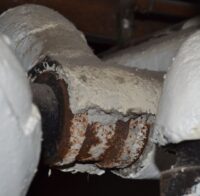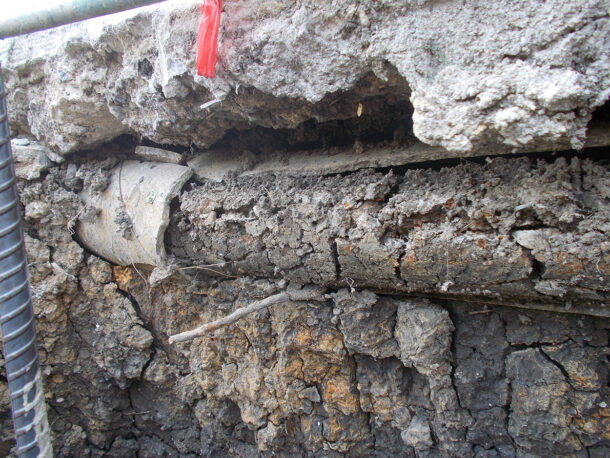Business texting is a convenient way to reach customers, so you can complete projects and get paid faster. Texts are sent and received within seconds, making them the preferred method of communication for customers to schedule services and receive updates. The quicker you can coordinate with customers, the more you’ll boost your contractor business’s reputation Read more
Guest Blog

Business texting is a convenient way to reach customers, so you can complete projects and get paid faster. Texts are sent and received within seconds, making them the preferred method of communication for customers to schedule services and receive updates.
The quicker you can coordinate with customers, the more you’ll boost your contractor business’s reputation and attract new business opportunities.
So how do you begin? These five tips below will help you connect with customers faster and increase your revenue flow.

-
Schedule service appointments via text
Streamlining your service scheduling process can make a crucial difference between potential customers choosing you over your competitors. Here’s how text messaging can help.
88% of people want to receive appointment scheduling texts from businesses. Customers love it as an option so they can reach out without having to make a call or send an email. Tell customers to text your business to schedule a service on your:
- Website
- Social media
- Advertisements
- In-office signage
- Service vehicles
Then when customers reach out to schedule an appointment, text a calendar link for them to book a time. This helps you connect quickly with your customers and coordinate where you need to be without skipping a beat. You’ll also be able to text for things like:
- Letting customers know if you’re arriving early or running late
- Asking for instructions on how to enter a property
- Rescheduling another time and date if anything comes up
- Enabling customers to reach out around the clock knowing they’ll get a response back
Keep services moving along by sending text reminders throughout the duration of a project, so you don’t miss out on lost time and revenue.
-
Send text service updates in real-time
Use text messaging to keep your team and customers on the same page at all times, so you can finish and get paid for projects faster. Depending on the situation, you can use texting to:
- Provide progress updates on a project
- Let customers know about any additional services that might need to be performed
- Ask for approval for additional charges
- Update customers on when you’re done for the day
MMS or picture messaging can go a long way when it comes to conveying these updates. For example, you can send pictures of areas that need work, completed jobs or the progress you’ve made, reps who will be doing the work, or even pictures of additional products customers may want to purchase along the way.
As you work through a project, you may need to follow up with customers to ensure progress continues to be made. Texting helps you get in contact with customers quickly, so you aren’t tied up on the phone when you could be working on a project. That means more projects done faster, and more revenue in your pocket.
-
Use texting to boost your customer service
Providing customer service via text can save you time and resources by reducing the need for phone calls or in-person meetings. Use texting to enhance your customer service by:
- Answering questions and concerns
- Encouraging customers to text photos and videos to illustrate a problem
- Following up with customers after a service
- Asking for a review
- General communications
By having your customer service communications all in one business text messaging platform, your team can easily see who’s been responded to and who still needs help. That gives you more accountability, insight into how your reps are responding, and an organized way to track customer interactions.
A solid text messaging platform will have a way to tag conversations, so you can assign contractors to specific customers based on their needs.
Most business texting software also allows you to leave private internal notes, so you have context when you revisit conversations. That way, you’ll be able to offer a more personalized approach to your customers every time you reach out.
-
Send promotions and offers with SMS marketing
Texting special promotions is a great way to attract new customers and retain existing ones. Share SMS offers like:
- Exclusive discounts and special offers to existing customers
- Free add-ons or upgrades to existing customers
- Combine multiple services for a discounted price, and promote them as a bundle
- Loyalty rewards for customers who use your services often
The best SMS promotions will be short, sweet, and tell customers exactly why it’s relevant to their specific needs and interests.
SMS marketing goes hand in hand with standard marketing methods such as social media, email newsletters, and other advertisements. You’re way more likely to get customers to take action when they see a back-to-back text, social post, and email about a new offer you have. Plus, 52% of people want to receive texts from businesses about promotions.
-
Settle bills with text payments
Get paid on time and more frequently when you enable customers to pay for your services through text, which is simply sending a link to an online portal for customers to pay.
Why should you consider text-to-pay for your business? It’s convenient, fast, secure, and can be done from anywhere. SMS payments work especially well for contractors since your team is constantly on the field at different locations, and the property manager might not always be present.
After completing a service, send a photo to prove you’ve finished, then text your customers a payment request with a secure link to pay. And if they have an upcoming bill or still haven’t sent a payment, text reminders are a great way to notify them of an outstanding balance. You can also ask customers for a new payment method if their current one is rejected or expired.
By providing a quick, convenient way to settle bills, you’ll speed up your cash flow and earn more money in the long run, while spending less to get it.
Reap the benefits of texting for your contractor business
Texting can be a powerful tool for contractors to communicate with customers while also promoting a wide range of services. With faster and more reliable communication, texting helps you increase your revenue, and boosts your business’s overall success.
Ready to use texting to leverage your contractor business? Find a business texting solution that’s right for you.
 Jessica Ayre is a content marketing specialist at Text Request, a business texting solution. If your business wants to start texting customers, Text Request can give you all the tools and resources you need to create a successful text messaging strategy.
Jessica Ayre is a content marketing specialist at Text Request, a business texting solution. If your business wants to start texting customers, Text Request can give you all the tools and resources you need to create a successful text messaging strategy.

Chris O’Grady, Chief Sales Officer, Successware Small business owners run into a slew of challenges every day, from customer service to accounting to managing the massive skilled labor shortage. Those in the home service trades are certainly familiar with these issues, as well as others that are unique to their industry. While many are daily Read more
Chris O’Grady, Chief Sales Officer, Successware
Small business owners run into a slew of challenges every day, from customer service to accounting to managing the massive skilled labor shortage. Those in the home service trades are certainly familiar with these issues, as well as others that are unique to their industry. While many are daily roadblocks that become business as usual, there are a few key issues related to business management software that fortunately can be easily improved upon. Addressing the following and embracing new tools will help you decrease overhead expenses and increase efficiencies by two to five times.
Issue #1: Trying to Integrate Multiple Software Packages Not Made for Our Industry, Combined with Poor Customer Service
If you have a big chunk of your expenses going towards multiple software packages, this is an area you’ll want to consider trimming. Many companies take an à la carte approach, choosing a business and field management system and then adding on a separate accounting package, dispatch system, call handling software, and more. They not only have to hire people with additional skill sets who know how to use the different systems, but they also end up duplicating efforts and data.
The right software should be designed specifically for your industry and be a one-stop shop for handling all of your small business’s needs. With the right platform, you won’t have to pay for extra software packages needed to run your business. This will then free up money for revenue-generating tasks.
You also want to choose a provider that offers a dedicated account manager, so you’re never left feeling like just another number. They should be a key resource for you and your employees, not someone you have to chase down for help or who doesn’t understand your industry. Good customer service is crucial during implementation of a new platform and beyond and can make or break how successful your company is with a new system.

Issue #2: Poor Data Quality from Duplicate Data Entry
Running different aspects of your business on multiple software packages means entering the same duplicate information into each system. This puts your data at risk for discrepancies and human error. Again, one platform will eliminate the confusion.
Additionally, data that lives in multiple places is harder to analyze. When service and job history data live in the same place as your financials, it is then possible to create detailed reports on the health of your business with all sorts of metrics at your fingertips.
You also increase your efficiencies when everything is consolidated in one place. You’ll see and feel the difference when you save travel time with smarter dispatching, can quickly access customer information and get paid faster in the field with digital payments.
Issue #3: Poor Connectivity in the Field
Having a team out in the field also means you need a reliable way to exchange information between them and the home office. With the right mobile application, the flow of information between dispatchers and technicians will be cohesive. Data can be entered from the job site and come right back into your back-office platform.
Features and tools in a well-designed mobile system can solve a lot of in-the-field issues for the home service trades. Think digital forms to eliminate cumbersome and costly paper forms, remote timecard management and integrated consumer financing that allows customers to get on-the-spot financing.
With the right field service management software and back-office platform, you can go from needing one admin to handle every two field reps to one admin that can handle up to four. Meaning you are not only becoming more efficient but can scale and grow your business like you may not have been able to before.
What Do These Issues Mean for You?
If the issues detailed above hit home, you are likely overspending on your overhead expenses by paying for multiple software packages. This also means your business isn’t running as efficiently as it could be. Taking a streamlined approach will eliminate some of these common industry issues and provide your team with features and tools that help your business stand out with your customers, your team and prospective employees.
 Chris O’Grady has been in sales for 30 years, focusing on software sales for the last 20. Chris has been leading and growing sales teams for most of his career, with his most recent positions at FinancialForce and CBORD, where he led high-performing sales teams and was able to help drive tremendous growth for each company. In April 2022, Chris joined Successware as the Chief Sales Officer. He brought with him a proven history of business growth and increased sales performance. In his current role, Chris leads sales, sales operations, and customer success and is responsible for driving sales strategy.
Chris O’Grady has been in sales for 30 years, focusing on software sales for the last 20. Chris has been leading and growing sales teams for most of his career, with his most recent positions at FinancialForce and CBORD, where he led high-performing sales teams and was able to help drive tremendous growth for each company. In April 2022, Chris joined Successware as the Chief Sales Officer. He brought with him a proven history of business growth and increased sales performance. In his current role, Chris leads sales, sales operations, and customer success and is responsible for driving sales strategy.

Most techs in the field want to be better, faster and more efficient at their jobs. Here are three things to focus on to help improve skills, satisfy customers and finish jobs more quickly and thoroughly. First, focus on airflow. HVACR is all about moving air around. No matter how efficiently a system runs, or Read more
Most techs in the field want to be better, faster and more efficient at their jobs. Here are three things to focus on to help improve skills, satisfy customers and finish jobs more quickly and thoroughly.
First, focus on airflow.
HVACR is all about moving air around. No matter how efficiently a system runs, or how expertly it’s fine-tuned, if the ductwork is too small, makes too many bends, has blockages or large gaps or leaks—the space is not going to be properly cooled or heated. Techs can frequently focus on “the box” because that’s where the technology is, and they ignore the rest of the system. Seasoned technicians understand the importance of airflow when installing a system, making sure duct systems are correctly sized, contain fewer bends, and allow for free flow of air throughout the entire home.
If you’re changing out a system, consider repairing or replacing necessary ductwork as well. Remember, older systems may contain asbestos, requiring certified professionals to aid in removal. Even in newer systems, it remains important to test for leaks and efficiency, so always be prepared to make revisions that improve overall performance in the long run.
Second, look for obvious problems.
When assessing a system, start with the easy stuff. Be alert and look for things that are out of the ordinary and may be symptoms of bigger problems. For instance, refrigerant oil stains on the floor could mean a refrigerant leak in the system. Use a flashlight to visually inspect the evaporator coils and blower wheels. By examining them for dirt or corrosion, you could uncover what’s causing the issues. Another quick, easy fix is the air filter. Swapping it out with a clean one immediately improves airflow and circulation.
Also, look for UV damage on control wiring. Sunlight tends to cause wiring to degrade prematurely, and this may adversely impact a system. By checking the entire system, it’s easy to judge the quality of workmanship and know how carefully to inspect other areas of the system.
Lastly, double-check your work.
No one intends to do subpar work, but sometimes steps are missed, and mistakes are made. Be sure to double-check everything throughout the day. This starts with caps and seals. Leaving them off is never OK. It’s a simple step to ensure they won’t be accidentally knocked onto the ground or lost behind a piece of equipment. Put caps and seals back on finger tight and snug hex flare caps up with a wrench.
When performing electrical work, don’t leave spade connections loose and don’t forget to properly torque contractor lugs. Also, never leave exposed wire. Strip back insulation to the length required to make the connection.
When the job is done and after performing a comprehensive run test at the end of a repair, do a final walk of the job and check all disconnects and set points. Also, perform a final cleanup and collect all tools. Leave nothing unchecked and nothing left behind.
While these three things are simple, they do help all HVACR techs work faster, safer and smarter on every job.
Pick up some of the latest in products for HVAC from Fieldpiece.

By Erich Litch, CEO of eSUB Construction Software “Change is not a four-letter word… but often your reaction to it is!” These words from author Jeffrey Gitomer ring true in the world of commercial trade contractors these days who are under growing pressure to do more labor with fewer workers. Thanks in part to a Read more
By Erich Litch, CEO of eSUB Construction Software
“Change is not a four-letter word… but often your reaction to it is!” These words from author Jeffrey Gitomer ring true in the world of commercial trade contractors these days who are under growing pressure to do more labor with fewer workers.
Thanks in part to a $1 trillion infrastructure bill, U.S. spending on commercial construction in 2023 will be robust, and commercial construction is projected to grow consistently over the next five years. However, the labor shortage within construction is also projected to be significant. The pandemic, the Great Resignation and an aging workforce have all contributed to a worker crunch, putting trade contractors on the back foot and making it even more important to create labor efficiencies wherever possible.
One of the best ways to gain greater efficiency is by using digital tools to speed up administrative processes and allow workers to access information more quickly and easily. In addition, you are protecting your company by documenting tasks more consistently and effectively so you can maximize revenue and substantially reduce financial risks.
Change can be hard, and you may not know where or how to start. Let’s fix that problem. Below is a four-step guide for using cloud software to automate processes and move information from boxes and file cabinets to anytime access at your fingertips on any device.
Walk Before You Run
Don’t try to start with everything. Instead, pick some high-value areas where you can get quick and significant returns, and focus on new document creation rather than digitizing previous paper documents. When creating new processes for document creation, Deloitte researchers, Jurrien Veldhuizen, Ilse Habraken, Peter Sanders and Rogier de Jong, recommend starting with processes that aren’t business-critical. Pick two or three processes (e.g. worksite photos and reporting hours) and try those in your new software. This lets you see what works and what doesn’t without disrupting normal business operations.
Some of the most valuable document types trade contractors get quick and significant returns on are field notes, daily reports, change orders, purchase orders, RFI’s and submittals. But you do not need to start with all of these. Start with basics like field notes and daily reports to make sure you document important job site developments and get your field workers comfortable with these tools. Then, add in the document types that are the most difficult to manage via paper and transfer all your project documents into one cohesive and easily accessible place. Gradually, you can begin moving other processes over to the software.
As you do so, be sure to document all these changes to your processes, DocuWare’s Joan Honig advises. “Then if issues arise in testing, you can determine whether they are due to the new platform or the new process.”

Select Software that is Tailored to Your Business and Easy to Use
Ensure the solutions you choose are designed for your users and your type of business. Many companies try to get their employees to use solutions that were designed for other types of companies or generically designed for other industries. This makes it much harder for employees to incorporate the technology into their daily work.
Also, organize training sessions to make sure users understand how to use the tools to do their work. Always look for ways to make the training accessible on-demand within their schedules, and give employees a way to learn at their own pace. A library of on-demand training videos and webinars can be a powerful tool to get your employees on board with your digital transformation.
Incorporate Other Document Types into Your Digital Processes
You will always encounter other sources of documents or files that are either paper or from digital platforms that are not part of your ideal cloud document management system. Make sure to identify these files and sources and develop processes to incorporate them into your digital strategy. Some important questions to consider are:
- Should paper documents be converted to digital formats and then uploaded to a single cloud storage solution?
- If you have multiple systems of digital document storage, can the systems be integrated to enable document sharing between systems?
- Does your cloud document management system allow uploading of different file types and provide unlimited storage of these types, or do they charge by usage?
If you are converting paper files to digital files or downloading digital files for uploading to another system, you need to create a standardized convention for naming each of those files and having a consistent file folder structure.
“This is incredibly important because records can then be stored logically, retrieved easily or browsed efficiently, saving time and minimizing frustration,” writes Steven Voight, knowledge development manager at InfinityQS International.
Voight has specific tips for creating those naming conventions:
- Make sure file names are meaningful but short (e.g. 012022Payroll).
- Don’t make file names unnecessarily repetitive or redundant.
- Don’t use spaces or underscores.
Once the files are sorted and named, they are ready for migration to wherever you plan to store them. Ideally, that would be in a cloud environment that is easily accessible to everyone on your team.
Be thorough during this step. You probably have lots of institutional wisdom tucked away in those paper documents. In an industry where talented people retire by the thousands annually, trades businesses need to preserve what they’ve learned over the years, according to National Fire Protection Association President and CEO Jim Pauley.
“In the fire, electrical and life safety industries, there’s a lot of ongoing conversation about how to preserve veteran wisdom,” he writes in Forbes. “With traditional communications methods, older generations are typically sharing information via email or in the margins of code books … Save for digging through the retiree’s email for any important lessons learned throughout their time, it’s almost impossible to ensure that their industry-specific knowledge is preserved for the use of future generations.”
Guide and Manage Your Team Through the Change
As we noted earlier, change is hard in any business. People tend to focus on the work that’s right in front of them, and asking them to change how they work can lead to resistance.
Support that change by doing three things:
- Make the change mandatory. Once the process is proven, make it an essential part of how you operate. A single employee might not understand how something they do impacts the organization as a whole. Don’t listen to the squeaky wheels and remember that the real value comes from widespread adoption and utilization.
- Educate and train your team. Host training sessions, and do what it takes to make sure every person understands the new workflow. But most importantly, ensure they fully understand why it is so important to use these tools.
- Hold people accountable. Set clear expectations for how and when you need people to adopt and begin using the new process, and hold your teams to them.
Learn More About Cloud-Based Construction Software
This guide is a broad overview of several complicated projects. Moving paper documents to the cloud and then creating new processes is a huge amount of work.
We built eSUB Cloud to be the software that supports that change in trades businesses. If you have any questions about how eSUB can support your company’s move from paper to software, contact us today to schedule a demo.
 Erich Litch is the Chief Executive Officer at eSUB Construction Software. He brings more than 20 years of executive leadership experience from positions in public and private software companies to this role.
Erich Litch is the Chief Executive Officer at eSUB Construction Software. He brings more than 20 years of executive leadership experience from positions in public and private software companies to this role.

The heat-resistant and insulating properties of asbestos led to its widespread usage in the building industry for quite some time. However, it poses serious health hazards when its fibers become airborne and are inhaled, causing lung cancer, mesothelioma, and asbestosis. This article will explore what asbestos is, where it can be found, and the dangers Read more
The heat-resistant and insulating properties of asbestos led to its widespread usage in the building industry for quite some time. However, it poses serious health hazards when its fibers become airborne and are inhaled, causing lung cancer, mesothelioma, and asbestosis. This article will explore what asbestos is, where it can be found, and the dangers associated with it.
What is Asbestos:
Properties of Asbestos
Asbestos is a naturally occurring mineral composed of thin, fibrous crystals. It is durable and has high tensile strength, resistant to heat, fire, and chemicals, making it attractive for insulation, roofing, flooring, and other construction materials.

Different Types of Asbestos
There are six types of asbestos, each with unique properties and characteristics. The three most commonly used types of asbestos in building materials are chrysotile, amosite, and crocidolite. The other three less commonly used types are tremolite, anthophyllite, and actinolite.
Where Can Asbestos Be Found?
Asbestos can be found in various building materials, including insulation, roofing shingles, floor tiles, and cement. It can also be found in automotive parts, such as brakes and clutches, as well as certain consumer products like hair dryers.
The Dangers of Being Exposed to Asbestos:
Lung Cancer
Lung cancer is one of the most well-known health hazards associated with asbestos exposure. Asbestos fibers that are inhaled can get stuck in the lung tissue, causing inflammation and scarring, leading to cancer. Symptoms of lung cancer can include coughing, chest pain, and shortness of breath, among others.
Mesothelioma
Another serious health problem associated with asbestos exposure is mesothelioma. This is a rare form of cancer that affects the lining of the lungs, abdomen, or heart. Mesothelioma can take years or even decades to develop after exposure. Symptoms of mesothelioma can include chest pain, shortness of breath, abdominal swelling, and more.

Asbestosis
Asbestosis is a chronic lung disease that can occur after prolonged exposure to asbestos. It is caused by the inhalation of asbestos fibers, which can cause inflammation and scarring in the lungs. Similarly, symptoms of asbestosis can include shortness of breath, chest pain, and a persistent cough. There is no cure for asbestosis, and treatment options are limited.
Other Health Hazards
Several other health hazards are linked to asbestos exposure, including a buildup of fluid in and thickening of the lining of the lungs. These conditions cause similar respiratory issues.
Asbestos exposure is especially dangerous for those who have worked in industries where it was or still is commonly used such as the construction and manufacturing industries. For example, in Massachusetts, asbestos at job sites such as shipyards, power plants, and factories created heightened exposure due to the widespread use of asbestos-containing materials in these industries.
Asbestos Regulations and Remediation:
Asbestos Regulations in the United States
The use of asbestos has been heavily regulated in the United States since the 1970s when the Environmental Protection Agency (EPA) began to study its health effects. Today, the EPA and other regulatory agencies have established strict guidelines for the handling and disposal of asbestos-containing materials.
Asbestos Remediation and Removal
If asbestos-containing materials are found in your home or workplace, hiring a licensed asbestos professional is important to remove them safely and effectively. This may involve sealing off the affected area, using specialized equipment to prevent the release of asbestos fibers, and properly disposing of the materials.
Asbestos Awareness and Education
Finally, raising awareness about the dangers of asbestos exposure is important in preventing future cases of asbestos-related illnesses. Many people are still unaware of the dangers of asbestos exposure and may unknowingly be at risk. Therefore, it is important to spread awareness and educate the public about the risks associated with asbestos to help protect future generations’ health and well-being.
Conclusion
In conclusion, asbestos is a dangerous material with serious health consequences for those exposed to its fibers. The best way to protect yourself from asbestos is to prevent exposure in the first place and to seek medical attention if you believe you may have been exposed. Asbestos regulations and remediation efforts can also help prevent future cases of asbestos-related illnesses. By staying informed and taking the necessary precautions, we can protect ourselves and our loved ones from the dangers of asbestos.

